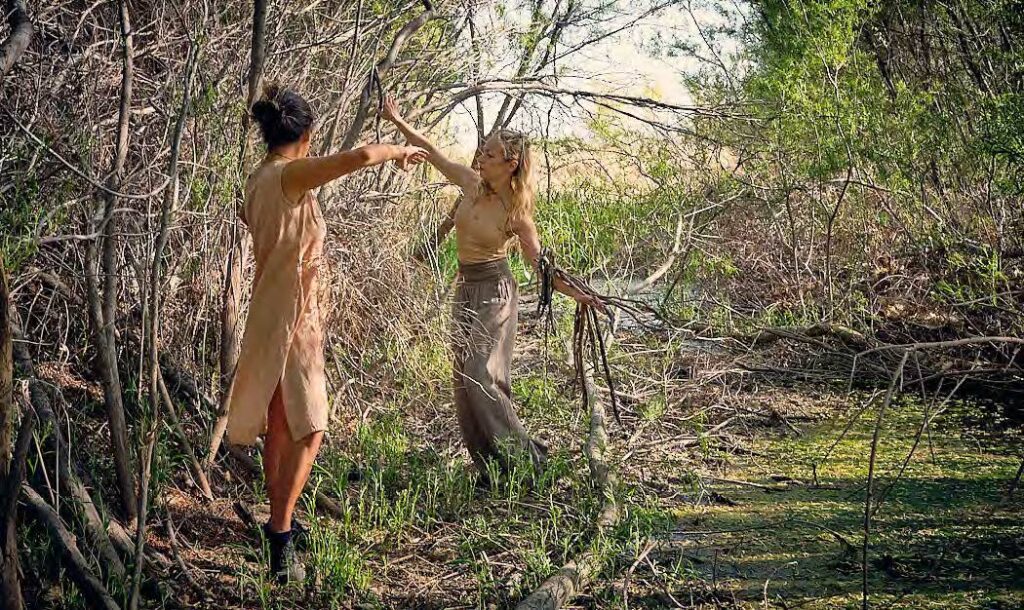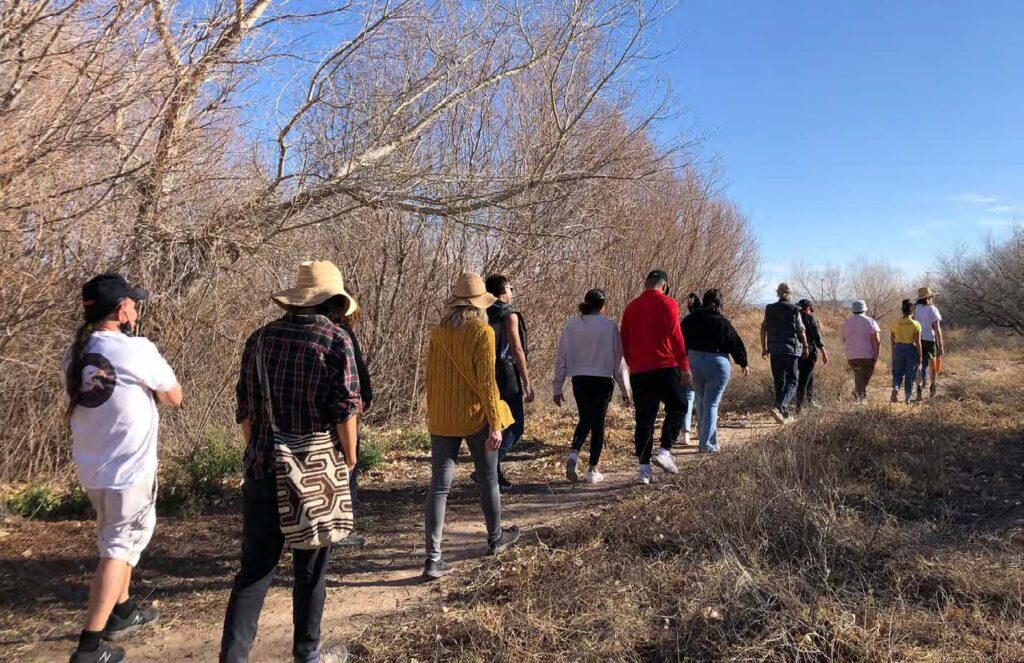By Heidi Schmelzer
Before the 1930’s, the area surrounding the Rio Grande river on the border of the United States and Mexico was filled with wetlands and riverside forests. Canals were built along the river to allow for the division of water between the United States and Mexico. While this system allowed for sharing of important water resources, it destroyed the surrounding habitat. In the face of climate change and further drought in the area, communities are looking into how to better utilize our resources and ensure water availability in the desert environment.
The Center for Environmental Resource Management (CERM) at The University of Texas at El Paso (UTEP) aims to address environmental health and water resources. One project includes restoring a small section near the river back to the native wetlands environment it once had. Somos Agua/ We Are Water is another group that aims to address water scarcity in the Paso del Norte Region. It uses an interdisciplinary approach combining arts and sciences to understand connections to the environment, facilitate community engagement, and ensure all living beings, humans, animals, and plants, have equal access to water in the area. We speak with two collaborators on these projects about the interdisciplinary approach and the importance of their work. Sandra Paola López Ramírez is an artist, cultural organizer, and Dr. Alex Mayer, Professor of Civil Engineering and Director of CERM. Both are located at The University of Texas at El Paso and collaborate in Somos Agua/ We Are Water.

Q & A: Paola and Alex
As a community organizer at The University of Texas at El Paso, how do you incorporate your arts and dance experience? [Paola]
As a performance activist, I have worked to radically integrate my interdisciplinary dance making with my community organizing for over a decade. I am passionate about democratizing the creative process and reigniting the creativity inherent in all human beings. In my work, the activity of making a dance or performance is the organizing activity. I create culture to organize community and organize community in the process of culture production— an activity that a mentor of mine describes as cultural organizing.
In our consumer capitalist society, cultural expression— our songs, dances, poems, stories— have become commodified to such an extent that most of us have become passive consumers of culture. I want people to remember that culture is not something static we are born into, but rather a complex, dynamic, living thing that we are actively and continuously co-creating. Using performance both as an organizing tool and as the result of the organizing itself, enables me to create spaces where people can rehearse their creativity while creating new ways to relate to themselves, each other, and the environment.
In my current position at The University of Texas at El Paso, I create these cultural organizing activities out of my home at the Rubin Center for the Visual Arts, a vibrant and radical space committed to making contemporary interdisciplinary art practices accessible and relevant in our border community. The robust support I get from the Rubin allows me to make the work more visible and magnify the impact of each project I develop.
Tell us about why the project Somos Agua/We Are Water was founded and how you merge art and science collaboratively. [Paola]
Founded in 2020, Somos Agua/We Are Water brings together an interdisciplinary group of scholars, artists and activists at The University of Texas at El Paso who are interested in finding innovative ways to solve water scarcity issues in our region. We all came together from a variety of fields and understandings about water with a desire to have a designated research space that was artist-led. Nurtured by a growing collaboration between the Rubin Center for the Visual Arts and the Center for Environmental Resource Management (CERM), Somos Agua offers an opportunity for us to learn from each other while generating shared understandings, having difficult conversations and creating new ways of moving forward.
For our work to be truly collaborative, the how we do this is being constantly recreated according to the needs and desires of our members. For example, a handful of us are working on a multi-year intervention at the Río Bosque Wetlands Park that aims to reconnect people to land and water while we learn about the Río Grande valley environment. We are doing this through the activity of creating a performance together in relationship to our students and the broader El Paso community. Through events at the park, we share our research with the public and each other creating ways to integrate sensory experience with scientific research. After each encounter, we document participants’ experiences with gestures, poems, written reflections, or drawings, which are then curated to create the content for the performance that will culminate the first phase of the project.

At CERM, why have you been focusing on the management of Río Bosque Wetlands Park? What impact have you had compared to its condition 100 years ago? [Alex]
Before the channelization of the Río Grande- Río Bravo in the mid-1930s, a bend in the river wound through today’s 372-acre Río Bosque Wetland Park. Instead of being confined to a straight, concrete channel, as we see today, the Río used to meander with many complicated loops and would periodically avulse and migrate within in its floodplain. Inside the Park is one of the loops that was cut off when the Río was channelized. The dream to restore this 2-mile, remnant section of the Río began in the mid- 1970s, but it took another 20 years to begin the restoration. CERM, along with our partners, agreed to manage the restoration activities, including removal of invasive vegetation, habitats typical of the Río and its floodplain in pre-colonial days (since around 1600 CE). Today, much of the native vegetation has returned, and the Park is an oasis for wildlife and people next to the channelized Río, which also happens to coincide with the US-Mexico border. The success of the habitat restoration in bringing back birds to the Park is especially remarkable the Park now hosts more than 200 different bird species over the year, including close to a hundred waterfowl species.
I think we need continued advances in science and engineering to understand how to manage our water better. But, I think the big lesson from successful efforts to restore or protect our water is that it takes hard, sustained, collaborative political work to convince people and institutions that it is worth it. We are approaching 50 years of work for the Río Bosque and can begin to say that the dream of restoring the habitat is almost there. There is yet work to be done into the future to continue to restore and protect habitats in the Park, especially as the land around the Park continues to be developed.
These efforts include carefully maintaining and growing the network of partners that contribute to sustaining the Park. Our arts and sciences collaboration, Somos Agua/We Are Water, is an example of how we want to expand engagement with the community.
Like elsewhere, our region is not homogeneous. Our arts-sciences collaboration is finding ways to connect to groups in the community who may not have interacted with the Park in the past, and to strengthen our ties with our partners.
I think that the arts can play a very important role in solving water problems in that the arts allow us to imagine what others may think are impossible and to approach problem solving in new, creative ways.
Finally, as an individual scientist-engineer, I would add that the collaboration is allowing me to see the human connections with the Río ecosystem in new ways, which is critical for advancing my own scientific research.

Final thoughts
We have learned that culture and community are important factors in understanding and assessing environment resources and their utilization. Combining art and community organization with the science of ecology and climate change is a fascinating approach to solve water scarcity in drought-prone and desert areas. It facilitates innovation and sharing ideas to find creative solutions to complex modern problems. Involving the community is an important aspect of this program because this hard work of addressing water scarcity requires much political effort and sustained engagement.
About the team
Dr. Alex Mayer is Professor of Civil Engineering and Director of the Center for Environmental Resource Management at University of Texas at El Paso. Dr. Mayer’s teaching and research focus on solving water resources problems. Current research topics include impacts of sea level rise on groundwater aquifers, water access in desert cities and under served populations, and climate change impacts on water availability.
Sandra Paola López Ramírez, MFA, is an interdisciplinary dance maker, cultural organizer, and mother. Her work radically integrates her creative process and her community organizing efforts creating small and large scale works that activate public spaces, non-traditional and formal performance venues, and natural landscapes. She is currently a Visiting Assistant Professor at The University of Texas at El Paso.
Find out more
Center for Environmental Resource Management (CERM): https://www.utep.edu/cerm/
Río Bosque Wetland Park: https://www.utep.edu/cerm/Río-bosque/Ríobosque-home.html
Sandra Paola López Ramírez artist: https://www.sandrapaolalopez.com/
Improvisa: http://www.improvisa.org
The Rubin Center for the Visual Arts: https://www.utep.edu/rubin/
Somos Agua: https://www.utep.edu/rubin/community-engaged-practices-in-the-arts1/we-are-water.html
